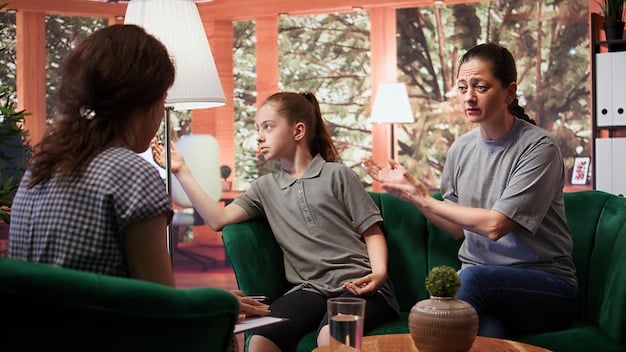How Social Comparison Theory Shapes Teen Self-Esteem in the US

Social comparison theory profoundly influences self-esteem among US teenagers by shaping their perceptions of self-worth through comparisons with peers, particularly amplified by digital platforms.
The teenage years are a critical period for identity formation, a time when young individuals navigate complex social landscapes and develop a sense of self. A pervasive, yet often underestimated, influence during this formative stage is the social comparison theory, particularly concerning how does social comparison theory influence self-esteem among US teenagers? This mechanism, wherein individuals evaluate their own opinions and abilities by comparing themselves to others, takes on new dimensions in an age saturated with digital interactions and idealized portrayals.
Understanding the Foundations of Social Comparison Theory
Social comparison theory, first formally introduced by Leon Festinger in 1954, posits that individuals have an innate drive to evaluate their opinions and abilities. In the absence of objective, non-social means, people turn to others for comparison. This fundamental human tendency becomes especially salient during adolescence, a period marked by rapid psychological and social development.
Festinger’s original formulation distinguished between two types of social comparison: upward and downward. Upward social comparison involves comparing oneself to those perceived as superior, often leading to feelings of inadequacy or inspiration. Conversely, downward social comparison involves comparing oneself to those perceived as inferior, which can boost self-esteem or foster complacency. The nuances of these comparisons are critical when examining their impact on teenagers, who are particularly vulnerable to external validation.
The Dual Nature of Comparison: Upward vs. Downward
In the context of US teenagers, both upward and downward comparisons play significant roles. Upward comparisons, prevalent on social media platforms, often involve idealized versions of peers’ lives, bodies, and achievements. This constant exposure can erode self-esteem as teens feel they fall short of unattainable standards. On the other hand, downward comparisons might provide temporary boosts, but relying on them can lead to a narrow view of self-worth based on others’ perceived shortcomings.
- Upward Comparison: Often linked to feelings of envy, inadequacy, and decreased self-worth, especially when comparisons are based on highly curated or unrealistic online personas.
- Downward Comparison: Can momentarily enhance self-esteem by highlighting one’s perceived advantages, but may also foster a sense of superiority or prevent genuine self-improvement.
- Lateral Comparison: Comparing oneself to peers of similar standing; often used for self-evaluation and validation within a peer group, contributing to a sense of belonging or competition.
The omnipresence of social media among US teenagers amplifies these comparison processes. Platforms like Instagram, TikTok, and Snapchat provide endless opportunities for comparison, making it difficult for teens to escape the pressure to measure up. The curated nature of online content often means teens are comparing their unfiltered realities to others’ highlight reels, setting a stage for potential self-esteem struggles.
Understanding these foundational aspects of social comparison is the first step in addressing its implications for adolescent well-esteem. The theory doesn’t just describe a psychological process; it illuminates why certain social environments, particularly digital ones, can be so impactful.
The Digital Echo Chamber: Social Media’s Role in Teen Self-Esteem
The advent of social media has undeniably reshaped the landscape of social comparison for US teenagers. These platforms, designed to connect, also inadvertently create powerful echo chambers where social comparison thrives. Research consistently points to a strong correlation between heavy social media use and fluctuating self-esteem among adolescents.
Unlike traditional, face-to-face interactions where comparisons might be more organic and limited, social media offers a seemingly infinite scroll of curated lives. Teens are exposed to an overwhelming amount of information about their peers’ perceived successes, physical appearances, and social lives, often leading to a skewed perception of reality. This curated reality can be particularly damaging, as teens struggle to reconcile their own experiences with the idealized versions presented online.
Curated Lives vs. Lived Realities
The “highlight reel” phenomenon on social media means that teens primarily see the best aspects of their peers’ lives: perfect vacations, flawless selfies, exclusive parties, and academic achievements. Seldom do they see the struggles, the rejections, or the everyday ordinariness that constitutes a complete human experience. This imbalance creates a psychological trap where teens begin to believe their own lives are inherently less interesting, less attractive, or less successful than those they observe online.
- Appearance Comparison: A significant driver of body image issues, as teens compare their physical appearance to often digitally altered or highly posed images.
- Lifestyle Comparison: Comparison of social activities, perceived popularity, and material possessions, leading to feelings of exclusion or material envy.
- Achievement Comparison: Academic, athletic, or extracurricular achievements of peers can lead to feelings of inadequacy if one perceives their own accomplishments as lesser.
The addictive nature of social media further exacerbates this issue. Constant checking and engagement mean continuous exposure to these comparisons, making it difficult for teens to disengage from the cycle. The instant gratification of likes and comments can offer fleeting validation, but the underlying drive for external approval often perpetuates a fragile sense of self-worth.
Moreover, cyberbullying, a direct consequence of online interactions, often stems from or contributes to social comparison issues. Taunts and negative comments amplify feelings of inadequacy and can severely damage a teenager’s self-esteem. The digital echo chamber, while offering connection, also amplifies the negative aspects of social comparison, making it a critical area of focus for parents, educators, and mental health professionals alike.

The Psychological Mechanisms Behind Impact on Self-Esteem
The influence of social comparison theory on self-esteem is not merely a superficial observation; it is rooted in deeper psychological mechanisms. When teenagers engage in social comparison, their brains process these evaluations in ways that directly impact their self-perception and emotional well-being. The interpretation of these comparisons—whether they are perceived as threatening or inspiring—determines the ultimate effect on self-esteem.
One key mechanism is the formation of a “social identity.” Adolescents are highly attuned to their social groups and seek to establish their place within them. Social comparison helps them gauge how they measure up against group norms and expectations. If they perceive themselves favorably, their self-esteem tends to be stable or boosted. Conversely, unfavorable comparisons can trigger feelings of anxiety, shame, and a decrease in self-worth.
Cognitive Distortions and Attribution Biases
Teenagers, whose cognitive abilities are still developing, are particularly susceptible to cognitive distortions and attribution biases when making social comparisons. For instance, the “better-than-average” effect can lead some teens to overestimate their own abilities compared to peers, while others might fall prey to “perfectionism,” setting impossibly high standards based on others’ perceived flawless lives.
- Fundamental Attribution Error: Attributing peers’ successes to internal factors (e.g., intelligence, talent) while attributing their own failures to external factors (e.g., bad luck), or vice-versa.
- Confirmation Bias: Seeking out and interpreting information in a way that confirms existing beliefs about oneself or others, which can reinforce negative self-perceptions if a teen already feels inadequate.
- Availability Heuristic: Overestimating the prevalence or importance of social media “highlights” because they are more readily available and visually striking, leading to distorted views of reality.
These cognitive processes can lead to a vicious cycle. Negative social comparisons can lead to reduced self-esteem, which, in turn, can make a teenager more likely to engage in further negative comparisons or to interpret ambiguous social cues in a self-deprecating manner. The emotional responses, such as envy, jealousy, or even social anxiety, further complicate this interplay, creating a complex web of psychological reactions.
The impact on self-esteem is not uniform; it varies based on individual differences in personality, resilience, and pre-existing mental health conditions. Teens with lower self-esteem or those prone to anxiety and depression may be more negatively affected by social comparisons, creating a greater need for targeted interventions and support systems.
Parental Influence and Peer Dynamics in Moderating Comparison Effects
While social comparison theory operates at an individual psychological level, its effects on US teenagers’ self-esteem are significantly moderated by external factors, primarily parental influence and peer dynamics. These social environments can either exacerbate the negative impacts of social comparison or act as protective buffers.
Parents play a crucial role in shaping a teenager’s self-esteem by providing a secure base, fostering a sense of unconditional worth, and teaching healthy coping mechanisms. Parental communication about social media use and the critical evaluation of online content can also equip teens with the tools to navigate digital comparisons more effectively. Open dialogue, understanding, and setting healthy boundaries around screen time can significantly mitigate adverse effects.
The Double-Edged Sword of Peer Influence
Peer groups are central to adolescent development, serving as crucial sources of social comparison. The dynamics within these groups can be a double-edged sword. On one hand, supportive peer relationships can offer validation, belonging, and a sense of shared experience that can counteract the negative feelings arising from upward comparisons. On the other hand, competitive or exclusionary peer environments can intensify negative social comparisons, further eroding self-esteem.
- Supportive Peers: Friends who offer genuine encouragement and validation can help teens develop a stronger internal locus of control and reduce reliance on external validation.
- Competitive Peers: If peer relationships are primarily driven by competition (academic, social, or physical), the constant striving to “outdo” others can lead to chronic stress and low self-esteem.
- Exclusionary Behavior: Social exclusion or bullying by peers can be devastating, amplifying feelings of inadequacy and loneliness, often triggering downward spirals in self-esteem.
Furthermore, teenagers often seek validation from their peers more than from their parents, making the quality of peer relationships particularly impactful. The desire to “fit in” and be accepted can lead to conformity, sometimes at the expense of individual well-being, further reinforcing the pressures of social comparison. Addressing the impact of social comparison requires a holistic approach that considers both the individual’s internal processing and the external social structures that shape their experiences.
Schools also have a significant role to play in fostering environments that promote positive self-esteem and discourage harmful social comparisons, perhaps through resilience-building programs and mental health education. By working collaboratively, parents, educators, and peers can create a more nurturing ecosystem for US teenagers.
Coping Strategies and Building Resilience in the Face of Comparison
Given the pervasive nature of social comparison, particularly in the digital age, equipping US teenagers with effective coping strategies and fostering resilience is paramount. It is not feasible to eliminate social comparison entirely, as it is a fundamental human tendency. Instead, the focus should be on teaching teens to engage in healthier forms of comparison and to develop robust internal resources to protect their self-esteem.
One crucial strategy involves promoting digital literacy and critical thinking about online content. Helping teens understand that social media often presents an edited and idealized version of reality can reduce the tendency to internalize unattainable standards. Encouraging them to question what they see online and to recognize the potential for impression management is a vital first step.
Cultivating Self-Compassion and Mindful Social Media Use
Self-compassion is a powerful antidote to the negative effects of social comparison. It involves treating oneself with kindness, understanding, and acceptance, especially during times of perceived failure or inadequacy. When teens are self-compassionate, they are less likely to be consumed by negative self-judgment arising from comparisons.
- Mindful Social Media Use: Encourage teens to be intentional about their social media consumption. This includes setting time limits, unfollowing accounts that trigger negative comparisons, and engaging with content that inspires rather than diminishes them.
- Focus on Internal Strengths: Shift focus from external comparisons to internal strengths and personal growth. Encourage teens to identify their unique talents, interests, and values, building self-worth from within.
- Seeking Positive Role Models: Instead of comparing themselves to impossibly perfect online personas, encourage teens to identify real-life or online role models who inspire them to grow and improve, rather than just feel inadequate.
Additionally, promoting involvement in activities that foster a sense of accomplishment and genuine connection, such as sports, arts, volunteering, or community groups, can build self-esteem independent of social comparison. These activities provide opportunities for mastery and belonging, which are critical for healthy adolescent development.
Parents and educators can also model healthy social comparison behaviors by focusing on personal progress rather than external benchmarks. Encouraging open discussions about feelings of inadequacy and normalizing struggles can create a safe space for teens to process their experiences without shame. Building resilience means empowering teenagers to navigate the complexities of social evaluation with a stronger sense of self and purpose.
Future Implications and Long-Term Effects on Adult Well-being
The impact of social comparison theory on self-esteem during adolescence extends beyond the teenage years, potentially shaping an individual’s psychological well-being into adulthood. Patterns formed during this formative period, particularly regarding how one views themselves in relation to others, can have significant long-term implications for mental health, career trajectories, and relationship dynamics.
Teenagers who consistently engage in upward social comparison and experience chronic low self-esteem are at higher risk for developing more severe mental health issues in adulthood, including anxiety disorders, depression, and eating disorders. These early experiences can hardwire certain cognitive patterns and emotional responses that are difficult to unlearn later in life.
Impact on Adult Relationships and Career Paths
The lessons learned from social comparison in adolescence can influence how adults approach relationships. Those with deeply ingrained feelings of inadequacy might struggle with trust, intimacy, or constantly seek external validation, leading to unstable or unfulfilling partnerships. Conversely, an over-reliance on downward comparison can foster arrogance or a lack of empathy, hindering genuine connection.
- Relationship Dynamics: Can lead to insecurities, jealousy, competitive behaviors, or a constant need for reassurance from partners if early comparisons were largely negative.
- Career Choices: May influence individuals to pursue careers based on external validation or perceived status rather than genuine interest or passion, potentially leading to dissatisfaction.
- Lifelong Mental Health: Chronic negative social comparisons can contribute to perfectionism, imposter syndrome, and a general feeling of not being “good enough,” impacting overall life satisfaction.
On a societal level, a generation of adults shaped by intense digital social comparison might exhibit different traits than previous generations, such as increased individualism, a heightened focus on appearance, or a greater propensity for anxiety. Understanding these potential long-term effects underscores the urgency of addressing social comparison’s impact during adolescence.
Interventions aimed at fostering healthy self-esteem and resilience in teenage years are not merely about navigating adolescence more smoothly; they are an investment in the psychological well-being of future adults. By empowering teens to develop a secure sense of self independent of external validation, we contribute to a more mentally robust and compassionate society.

Addressing the Challenges: Collective Responsibility
The pervasive influence of social comparison theory on the self-esteem of US teenagers necessitates a collective and multi-faceted response. It is not solely the responsibility of parents or educators but requires a coordinated effort from various societal stakeholders, including technology companies, policymakers, and mental health professionals. Addressing these challenges effectively requires a clear understanding of the roles each entity can play.
One key area is education. Schools can integrate curricula that teach digital literacy, media consumption skills, and critical thinking from an early age. These programs can help teenagers develop the discernment needed to navigate the often-misleading narratives presented on social media. Understanding the difference between reality and curated online content is fundamental.
The Role of Technology Companies and Policy Makers
Technology companies, the architects of the platforms where much of this social comparison occurs, bear a significant responsibility. Designing features that promote well-being over engagement, implementing stricter age verification, and offering tools for managing screen time and content exposure can make a substantial difference. Furthermore, transparency about algorithms and data usage could empower users to make more informed choices.
- Platform Design: Companies should prioritize features that promote positive interactions and reduce addictive design elements that encourage constant comparison.
- Content Moderation: Stricter policies around cyberbullying and harmful content are necessary to create safer online environments for teenagers.
- Policy & Legislation: Governments and regulatory bodies can implement policies that hold tech companies accountable for the mental health impacts of their platforms on young users, fostering responsible innovation.
Mental health professionals are also crucial, providing direct support to teenagers struggling with low self-esteem and body image issues stemming from social comparison. Therapy, counseling, and support groups can offer safe spaces for teens to process their feelings, develop coping mechanisms, and rebuild their self-worth.
Finally, fostering a cultural shift that values authenticity, personal growth, and intrinsic worth over external validation is essential. This involves challenging societal norms that prioritize material wealth, superficial beauty, or constant achievement as the sole measures of success. By celebrating diverse forms of success and emphasizing effort and resilience, we can collectively create an environment where US teenagers feel less pressure to conform and more empowered to be themselves.
| Key Aspect | Brief Description |
|---|---|
| 🔄 Comparison Types | Teens engage in upward (inferiority) and downward (superiority) comparisons impacting self-worth. |
| 📱 Social Media Amplification | Platforms magnify comparisons through curated content, often leading to unrealistic expectations. |
| 🧠 Psychological Impact | Cognitive biases and emotional responses influence how comparisons are processed, affecting self-esteem. |
| 🛠️ Coping Strategies | Promoting digital literacy, self-compassion, and focus on internal strengths builds resilience. |
Frequently Asked Questions About Social Comparison and Teen Self-Esteem
▼
Social comparison theory suggests that people evaluate their own abilities and opinions by comparing themselves to others. For teenagers, this often means measuring their appearance, achievements, and social status against peers, particularly those seen on social media, impacting their self-perception.
▼
Social media amplifies comparison by constantly exposing teenagers to curated, often idealized, versions of peers’ lives. This “highlight reel” phenomenon creates an unrealistic benchmark, making teens feel consistently inadequate when comparing their everyday reality to others’ online perfection.
▼
Yes, social comparison can be positive if it serves as a source of inspiration or motivation. Upward comparison can encourage self-improvement, while downward comparison can foster gratitude. However, for it to be positive, teens need healthy self-esteem and the ability to critically evaluate what they see, avoiding feelings of envy or superiority.
▼
Parents are crucial in mitigating negative effects by fostering open communication about social media, teaching critical media literacy, modelling healthy self-esteem, and encouraging activities that build intrinsic value. Creating a loving, accepting home environment reduces the need for external validation from comparisons.
▼
Long-term effects of negative social comparison can include chronic low self-esteem, increased risk of anxiety and depression, difficulty forming healthy relationships due to insecurity or competitiveness, and making career choices based on external validation rather than personal fulfillment, impacting overall well-being.
Conclusion
The profound influence of social comparison theory on the self-esteem of US teenagers is an undeniable and complex challenge of our modern era. Amplified by the omnipresence of digital platforms, this innate human tendency shapes how adolescents perceive their worth, often leading to feelings of inadequacy, anxiety, and a diminished sense of self. Addressing this critical issue requires a multi-faceted approach, encompassing greater media literacy education, fostering self-compassion, promoting healthy peer dynamics, and holding technology companies accountable for the mental well-being of their young users. By collectively working towards creating more supportive environments and empowering teens with robust internal resources, we can help them navigate the pressures of comparison, cultivate a resilient sense of self, and build a foundation for lasting psychological well-being into adulthood.





